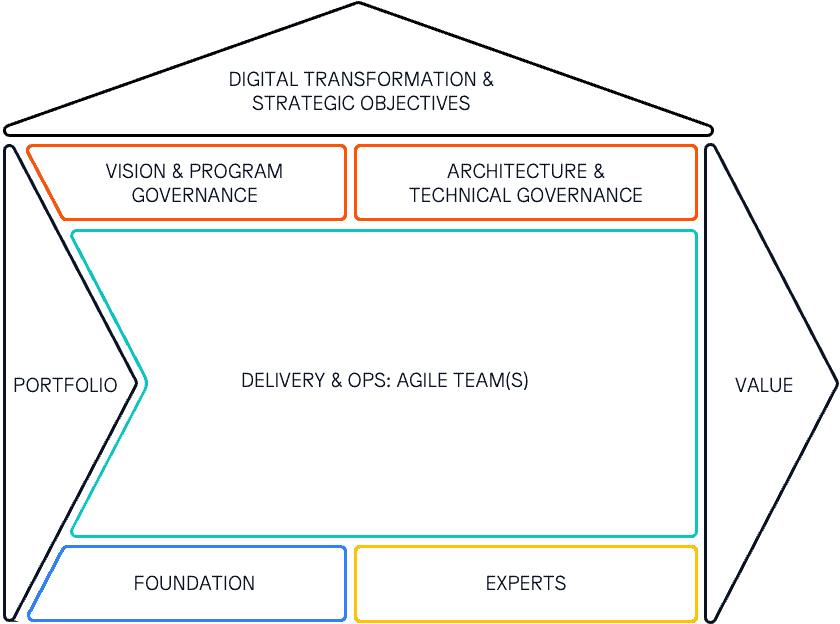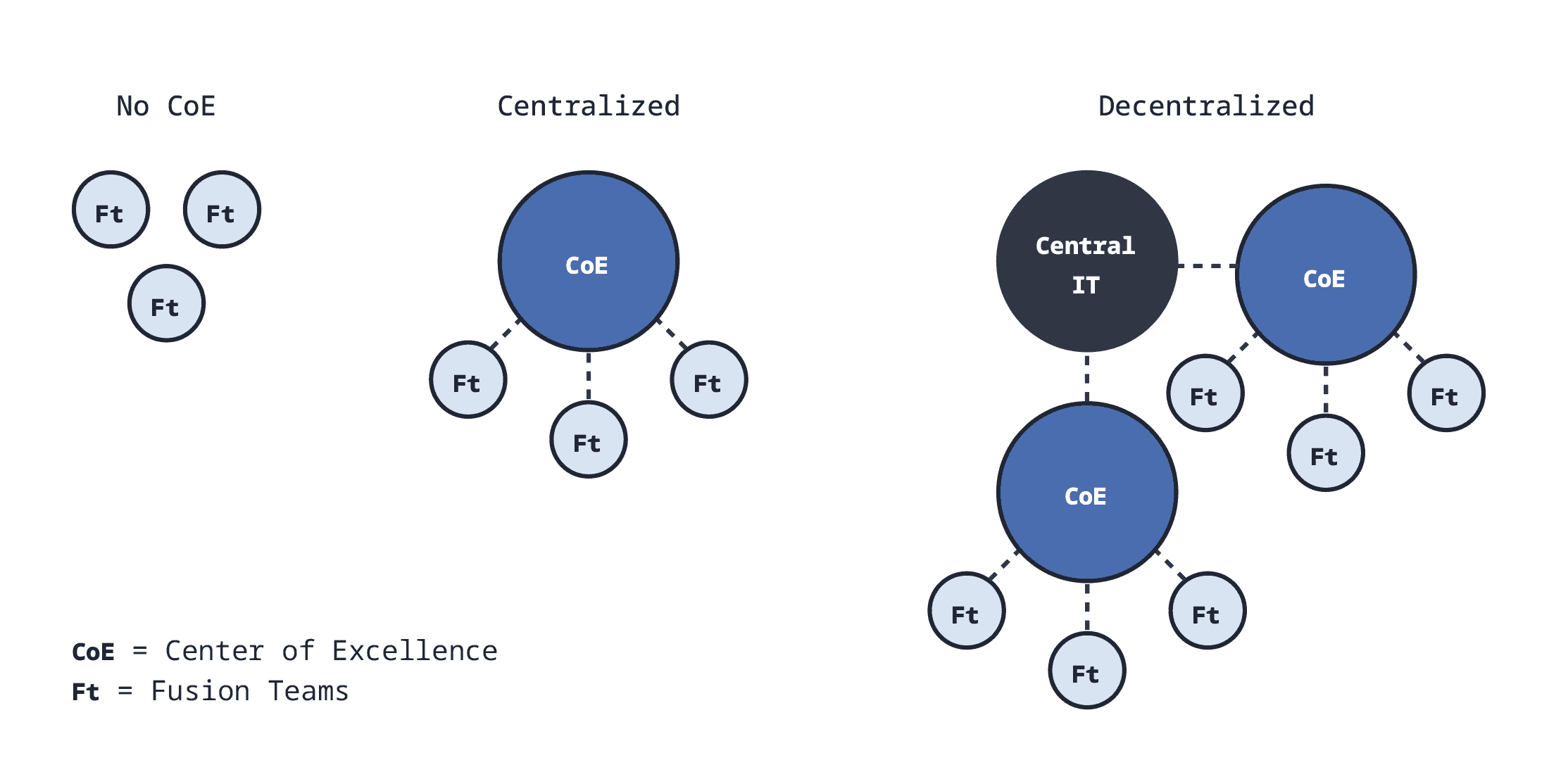How to Build a Low-Code Center of Excellence

In the dynamic landscape of digital transformation, organizations recognize the need for a more active and evolved approach to software development. It’s why so many are adopting enterprise low-code application development platforms.
The right low-code platforms abstract software development, creating opportunities to simplify complex development projects like legacy modernization or innovating with AI.
Looking at the latest edition of the Gartner Magic Quadrant for Enterprise Low-Code Application Platforms, you can see that the Mendix platform is ready-made for building enterprise software at scale.
We believe what keeps us in the low-code leadership conversation is our ability to help our customers develop a new way of delivering software. Success doesn’t just happen because of our leading technology. It’s our platform plus a more dynamic and participatory model of software delivery.
We have decades’ worth of experience helping customers transform their approach to software development and the way they do business. We’ve codified that into a set of guidelines we call the Digital Execution Practice.
Following these guidelines, our customers can build and maintain Low-Code Centers of Excellence, so that they can repeatedly deliver the software their organizations need.
Before diving into the what and how of establishing a Low-Code Center or Excellence, let’s take a look at how LATO – our composite organization – CIO Claire Shah experienced setting up the LATO CoE:

What is a Low-Code Center of Excellence?
When looking to meet software demand, a Low-Code Center of Excellence (CoE) is a muscle that they need to build.
Unlike the somewhat lofty connotations you might assume when you hear “Center of Excellence,” a Low-Code Center of Excellence underscores the active, evolving nature of low-code development.
It’s not about achieving a static state of perfection. Rather, it’s a journey of continuous improvement, collaborative learning, community building, and practical application.
A Low-Code CoE enables a fusion teams approach. Fusion teams, a concept classified by Gartner, focuses on the multidisciplinary nature of digital business teams.
Fusion teams work together with the goal of delivering products, regardless of where they sit in an organization. This concept helps organizations establish a constructive and conscious common language centered around business needs, architecture, and deployment to help deliver applications at scale.
The Anatomy of a Low-Code Center of Excellence
The five critical components of Digital Execution, what Mendix refers to as the 5 P’s, form the foundation of a successful Low-Code CoE.
- Portfolio
- People
- Process
- Platform
- Promotion

Vision and Program Governance: A pivotal component is the people responsible for leading and organizing this capability—providing both a vision for what should be achieved and overseeing its execution.
Architecture and Technical Governance: Integration with the broader landscape and the provision of a structured approach requires architecture and governance. They should adhere to your company’s architecture rules and governance standards.
Experts: Ensuring that adherence and that the software’s requirements are what users are demanding are the domain experts. In complex IT landscapes, organization-specific and technical (Mendix) expertise are imperative. Experts like UI/UX or QA specialists play a crucial role, too.
Foundation: The training both technical experts and domain experts receive to use Mendix (blue bottom rectangle) is important because their work creates the foundational building blocks needed for acceleration—like a Design System or setting up Automated Testing.
Note that the delivery capability (Portfolio, Delivery, and Ops, Value) itself isn’t necessarily integrated into the Low-Code CoE. The CoE provides the structure and guidance to make the delivery capability as efficient as it can be.
You can read here how the City of Rotterdam empowered development at scale.
Start, Structure, Scale
Now that we understand the fundamental elements of a Low-Code Center of Excellence, the question becomes: How do you build one?
The answer lies in our structured Digital Execution Practice, which encompasses three key phases: Start, Structure, and Scale. Each phase recognizes its own key milestones and activities for the 5 P’s.
We’ve structured our methodology into playbooks that span from strategic objectives to technical domains. These playbooks offer comprehensive guidance by explaining when specific activities should be initiated and the stakeholders involved. This fosters a clear roadmap for successful execution.
Start
The initial ‘Start’ phase ignites your low-code journey. Organizations begin by:
- Identifying key individuals
- Defining objectives
- Selecting the appropriate low-code platform, such as Mendix
This phase is about laying the groundwork while delivering tangible results.
Organizations at ‘Start’ focus on building a single app development team, concentrating on building expertise. A pivotal milestone within the ‘Start’ phase is the team’s successful delivery of its first low-code application. This achievement not only demonstrates the viability of the chosen low-code platform but also serves as a catalyst for building enthusiasm and support across the organization.
Structure
As the Low-Code Center of Excellence gains momentum, organizations move to the ‘Structure’ phase. Teams start developing their first portfolio of low-code applications (Portfolio) guided by leaders identified in the ‘Expert’ area (People).
In this phase, you move from the “one app, one team” of ‘Start’ to breaking up the experienced team into several units, disseminating knowledge, and fostering scalability.
Also, at this point, appointing a Program Owner is crucial to the continued growth of your Low-Code CoE. Program Owners:
- Provide strategic leadership, ownership, and accountability
- Communicate to stakeholders
- Foster adaptability
- Ensure efficient resource management and cross-functional collaboration
Scale
Your ultimate goal for your Low-Code Center of Excellence is the ‘Scale’ phase, characterized by the seamless integration of all Low-Code CoE components. At this stage, your organization boasts well-established processes, and employees are proficiently delivering software with low-code.
Focusing on ‘Process’, a thriving Low-Code CoE asserts its strength through three vital activities:
- Taking ownership of governance and methodology
- Executing deployments at scale
- Implementing automated testing
These actions ensure robust control, widespread implementation, and rigorous quality assurance.
How to Position Your Low-Code Center of Excellence
Building your Low-Code Center of Excellence is one thing. But a strategic consideration arises with how you then position the CoE within your organization.
Do you use a centralized or decentralized model? The diagram below illustrates both:

The distinction between a centralized and decentralized Low-Code Center of Excellence lies in the organizational structure and decision-making processes.
- In a centralized Low-Code CoE, key functions and decision-making are concentrated at a central hub, offering standardization. Here, all responsibilities and development initiatives sit with the CoE, which ensures all standards and processes are in place.
- Conversely, a decentralized Low-Code CoE distributes responsibilities across various units, allowing for localized decision-making and adaptation to diverse regional needs. A Central IT team is responsible for technical governance (architecture, security, etc.). This is advantageous for more global organizations where business units or offices in different locations may have specific needs.
Schaeffler is a great example of an enterprise that has successfully set up a Low-Code Center of Excellence at Scale.
By following our methodology, organizations can accelerate their transformation in a controlled manner, ensuring sustained success.
Supercharge Your Journey to Scale
If you’re looking to speed up your journey to scale, Mendix offers a services package that not only accelerates low-code adoption but also imparts Digital Execution and best development/operation practices to your teams.
The Digital E framework in that services package empowers agile business engineering. With essential tools and online training, it streamlines Mendix development, helps you cut costs, and fast tracks your time to value.
The beauty of working with Mendix is that whenever you embark on your low-code journey, you can do it at the speed you choose.
